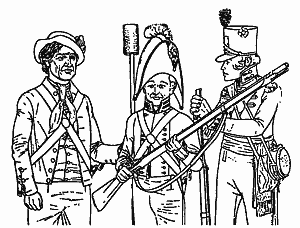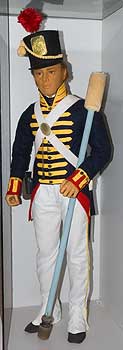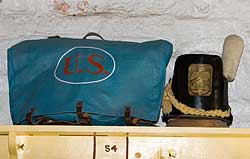
The Defenders of Fort McHenry

|
|
Uniform of a Private, 3rd Regiment, U.S. Artillery.
|
The 1,000 men who defended Fort McHenry during the Battle of
Baltimore were members of three fighting units. The first group
was members of the U.S. Army "Corps of Artillery." These men
lived at Fort McHenry and were paid eight dollars a month for
their services. The "Corp of Artillery" uniform consisted of a
dark blue jacket called a "coatee." It had a high red collar
trimmed with yellow, and a single row of brass buttons down the
front. In addition, the men were given a linen shirt, one pair
of white summer trousers, and one pair of blue wool trousers. A
stiff felt hat, called a "shako" protected the soldier's head,
much as a helmet would.

|
|
Supplies issued to soldiers at Fort McHenry.
|
Another group of defenders was the "Maryland Militia," private
citizens who felt it necessary to aid in the defense of the city.
Militiamen were volunteers who were not paid until April 1813,
when the militia was federalized for 30 days and released. From
early August through September 20, 1814, the militia was
federalized again, and the volunteers were paid and given rations.
These men came from all walks of life - bakers, tailors,
shipbuilders, merchants, bankers and lawyers. The uniform was a
blue wool jacket with a red collar and cuffs, a white linen shirt
and white trousers. Militiamen wore large, black felt hats,
trimmed in yellow and adorned with a large red feather.
The third group was sailors from Commodore Joshua Barney's Flotilla,
which had been formed in 1813 to provide naval protection for the
Chesapeake Bay. Sailors did not have a regular uniform. Sometimes
the ship's captain would decide what the crew would wear. It is
likely, however, that many sailors wore blue wool jackets and vests.
Their trousers, usually white, but sometimes blue striped, many have
been made from linen or heavy canvas. Sailors wore hats that had
been waterproofed with "tar" to protect the hat while at sea.
In spite of their different uniforms, the three groups of men had one
thing in common - the protection of Baltimore from destruction. The
bravery of these men and their skill in operating the canons helped
defend Baltimore. Cannon firing was a difficult and dangerous job.
Artillery soldiers drilled long and hard until they could load and fire
the guns four times in one minute. There was always the possibility
that a cannon might explode, killing the crewmembers. Often, men lost
their hearing from the frequent, loud cannon blasts.
(Information courtesy of the National Parks Service)
Copyright © 2006 Calvin & Rosanna Hamilton. All rights reserved.


